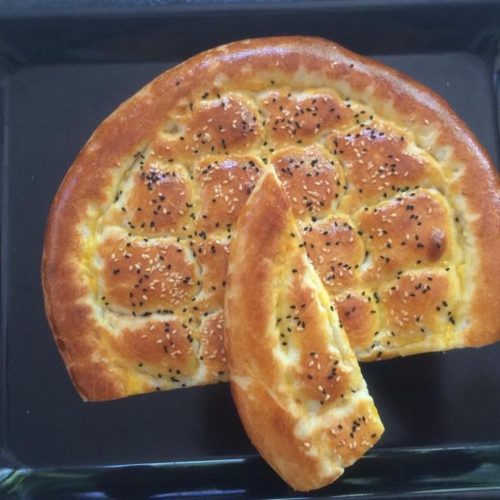My post today is a type of bread called pide, it is immediately associated to Ramadan, a month when Muslims fast during the day. This pide takes its place among the usual breads in bakeries. It is not an unusual site to see queues in front of bakeries for pide. Everybody wants to buy the warmest one, as pide is at its best when just out of the oven. Bakeries often hire additional pide experts during Ramadan to keep up with the demand. The Ramadan pide has been famous since Ottoman times.
There are basically four stages preparing pile; kneading, fermentation, shaping and baking. While making this dough, use warm water to activate the yeast. You will get a medium density, slightly sticky dough. Please do not add flour once you reach this texture, it should not be stiff. You might want to use a dough scraper to help you move the dough around. Please do ferment, in the first stage the dough should almost double in size. It will help you to shape more easily if you lightly oil your hand or even brush your hand with some egg yolk while shaping.
It is not very likely but in case you do have left overs keep in the fridge and heat before serving, not in a microwave but in the oven or in a skillet on the stove. You can also consider preparing meatballs with pide recipe.
Enjoy.
Ramadan Flatbread
Ingredients
Yeast
- 10 grams instant yeast
- 75 millilitres warm water
Dough
- 1 kilogram flour
- 400 millilitres milk
- 100 millilitres sunflower oil or similar
- 2 egg whites
- 1 teaspoon salt
- 1 teaspoon sugar
Spread
- 2 egg yolks
- 1 tablespoon butter melted
- 3 tablespoons milk
- 1 teaspoon nigella seeds
- 1 teaspoon sesame seeds
- 1 tablespoon breadcrumbs
Instructions
Yeast
- Prepare a small bowl of 75 millilitres of warm water. Warmth should be around 50° Celsius, if thermometer is not available, dip your pinky finger in the water. If you can barely keep your finger for a count of 7 the warmth should be fine. Add the instant yeast, whisk to dissolve. Cover and set aside to activate for about 10 minutes.
Dough
- Meanwhile mix most of the flour with the other dough ingredients with a wooden spatula in a large bowl.
- Then add the instant yeast mixture.
- Stir in the bowl until all the ingredients are well mixed using a spatula. Then either in the bowl or a working space start kneading. Occasionally pick up the dough and some what beat it back down. At the end of 4-5 minutes, the dough will become smooth. Add more flour if necessary. You can wet the dough slightly using wet hands. This will make your dough elastic and more delicious. You should obtain a soft and somewhat sticky dough.
- Then cover your dough with a clean damp towel and set aside for about an hour.
- Cut the dough into 2 pieces.
- Sprinkle some breadcrumbs onto an oven sheet and place one of the dough pieces on top. With your hands make a round flat shape. Breadcrumbs will help bottom of the pide not to stick and will also help having it more crispy.
- Then with the side of your pinky fingers first make a round outer circle, 1 centimetre from the sides. Also make three straight lines inside the circle and three crossing diagonal lines crossing the straight line. As seen in the picture.
- Do the same with the other dough piece.
- Let the pide rest for another 15 minutes, before going into the oven.
Spread
- Whisk the egg yolks.
- Add the melted butter and the milk, mix.
- Spread all around the top of each pide using an egg brush.
- Sprinkle with sesame seeds and nigella seeds.
- Bake in a pre-heated oven at 200° Celsius for about 30-35 minutes, until top and bottom is golden.
- Keep covered after cooled.

